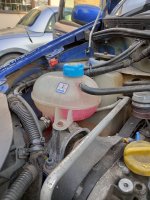My 100hp Panda suddenly started misfiring. Seemed like it was running on three cylinders. I plugged my code reader in and got:
P0300 Random Cylinder Misfiring
P0302 Cylinder 2 Misfiring
P0303 Cylinder 3 Misfiring
I swapped out the ignition coils on 2 & 3 with some old used ones believed to be ok and put in a complete set of new plugs that I had.
This made no difference. I topped up the coolant before my last journey as it was about 1" below the midpoint on the reservoir. It has now dropped to that same level. The attached photo shows what happens to the coolant level with the engine running. It drops to the bottom of the reservoir on the left side and goes up on the right side.
I think there is a slight smell of hot coolant. There was also some slight steam but I couldn't tell where it was coming from. The temp gauge reads normal. When I plugged the code reader in a second time it came up with misfire messages for cylinders 1&2.
I'm thinking it must be a blown head gasket. I have a compression tester on the garage but haven't looked at it yet to see if I can use it with the deeply recessed plug holes.
Is that the way to go please? Or does it seem obvious that it's the head gasket at fault?
P0300 Random Cylinder Misfiring
P0302 Cylinder 2 Misfiring
P0303 Cylinder 3 Misfiring
I swapped out the ignition coils on 2 & 3 with some old used ones believed to be ok and put in a complete set of new plugs that I had.
This made no difference. I topped up the coolant before my last journey as it was about 1" below the midpoint on the reservoir. It has now dropped to that same level. The attached photo shows what happens to the coolant level with the engine running. It drops to the bottom of the reservoir on the left side and goes up on the right side.
I think there is a slight smell of hot coolant. There was also some slight steam but I couldn't tell where it was coming from. The temp gauge reads normal. When I plugged the code reader in a second time it came up with misfire messages for cylinders 1&2.
I'm thinking it must be a blown head gasket. I have a compression tester on the garage but haven't looked at it yet to see if I can use it with the deeply recessed plug holes.
Is that the way to go please? Or does it seem obvious that it's the head gasket at fault?



